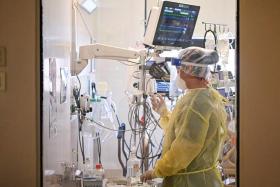Talking may be as dangerous as sneezing in virus spread
Microdroplets from speaking can stay in the air for 20 minutes, stressing need for masks and safe distancing
Conversing with others may seem innocuous, but it can be as dangerous as coughing or sneezing in spreading the coronavirus, say experts.
This underscores the importance of wearing a mask and practising safe distancing, they added.
A recent experiment by researchers in Japan used high-definition cameras and laser lighting to capture the emission of respiratory droplets from the airways of two people having a conversation .
The researchers found that microdroplets less than 100th of a millimetre in size can linger in the air for 20 minutes in enclosed spaces.
Commenting on the findings, infectious disease expertGregory Poland, head of vaccine research at the world-renowned Mayo Clinic in the US state of Minnesota, told The New Paper: "When you are speaking loudly... or even talking in an animated way, you are necessarily exhaling, and when you do that, respiratory droplets are expelled.
"What this study suggests is that it may be equally dangerous (to talk)."
Previously, it was commonly believed that the larger 1mm droplets expelled in coughs and sneezes were responsible for the spread of the virus, but recent clusters indicate a possibility of microdroplets having a sizeable impact on transmission.
The experiment found droplets from a sneeze fall quickly to the ground and do not travel far, even in still air. But microdroplets drift about in the air.
The researchers estimate a single cough or sneeze can produce 100,000 microdroplets.
Dr Piotr Chlebicki, an infectious disease specialist at Mount Alvernia Hospital, said: "From the way it spread on cruise ships and in the dormitories here, we can see the risks the spread of microdroplets pose to people in enclosed spaces, because they stay in the air for a longer period."
Infectious disease expert, Dr Leong Hoe Nam, who believes more research should be done to further validate the experiment's hypothesis, told TNP: "It was always an assumption that transmission is through coughing or sneezing, but the Japanese study reminds us these microdroplets may spread even when talking.
"This means the virus can be transmitted a lot more casually than people might think."
Dr Leong, who practises at Mount Elizabeth Hospital, said such casual transmission of the coronavirus is compounded by the likelihood of asymptomatic transmission, whereby infected persons who have no symptoms may unknowingly spread the virus to those around them.
"What's more, the viral load of the coronavirus is particularly high.
"Viral copies found in the respiratory tract for patients of classic influenza or other cold viruses would amount to about 100,000 or a million copies per swab," he added .
"With the coronavirus, we are possibly talking about a billion copies, and that is in asymptomatic patients.
"For droplets of the coronavirus to lead to an infection in others, transmissibility is higher than with other cold viruses. This is not a traditional virus."
STAND FARTHER APART
As an added precaution, Dr Leong suggested people stand at least 2m apart, beyond the 1m safe distance advised by the World Health Organisation.
Good ventilation in homes and workplaces will help to remove the microdroplets, said Dr Poland.
The experiment shows the microdroplets were quickly swept away by any airflow in a room.
Most crucially, people should be properly masked when they leave home.
Dr Chlebicki said: "Wearing a mask is more about preventing yourself from spreading the virus to others - especially when you may not even know you have it - and less about protecting yourself from catching the virus.
"A mask reduces the amount of aerosol produced when you talk, cough or sneeze, and fewer droplets are released into the air."
Wearing a mask in public was made compulsory last Tuesday, before which reusable masks were distributed to all households in Singapore.
While cloth masks may be deemed less effective than surgical masks in filtering out droplets, the combined efforts of everyone wearing a mask will help achieve a lower risk of transmission, said Dr Leong.
Researchers at the Agency for Science, Technology and Research (A*Star) have developed a cloth mask that people can make at home, using everyday household items, including a cotton T-shirt, dried wet wipes and masking tape.
In response to TNP's queries, its spokesman said a good homemade mask should cover one's nose and mouth, and have an absorbent inner layer and good breathability.
The A*Star-designed masks were tested to have "essential properties close to that of surgical masks" and were validated by an independent testing house, the spokesman added.
Get The New Paper on your phone with the free TNP app. Download from the Apple App Store or Google Play Store now


